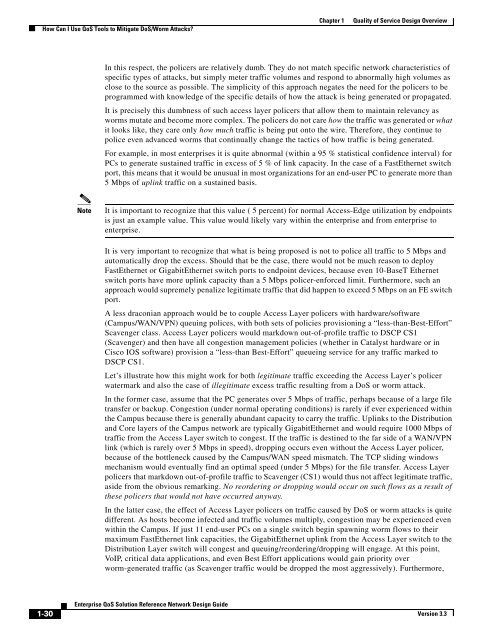Enterprise QoS Solution Reference Network Design Guide
Enterprise QoS Solution Reference Network Design Guide
Enterprise QoS Solution Reference Network Design Guide
Create successful ePaper yourself
Turn your PDF publications into a flip-book with our unique Google optimized e-Paper software.
How Can I Use <strong>QoS</strong> Tools to Mitigate DoS/Worm Attacks?<br />
1-30<br />
<strong>Enterprise</strong> <strong>QoS</strong> <strong>Solution</strong> <strong>Reference</strong> <strong>Network</strong> <strong>Design</strong> <strong>Guide</strong><br />
Chapter 1 Quality of Service <strong>Design</strong> Overview<br />
In this respect, the policers are relatively dumb. They do not match specific network characteristics of<br />
specific types of attacks, but simply meter traffic volumes and respond to abnormally high volumes as<br />
close to the source as possible. The simplicity of this approach negates the need for the policers to be<br />
programmed with knowledge of the specific details of how the attack is being generated or propagated.<br />
It is precisely this dumbness of such access layer policers that allow them to maintain relevancy as<br />
worms mutate and become more complex. The policers do not care how the traffic was generated or what<br />
it looks like, they care only how much traffic is being put onto the wire. Therefore, they continue to<br />
police even advanced worms that continually change the tactics of how traffic is being generated.<br />
For example, in most enterprises it is quite abnormal (within a 95 % statistical confidence interval) for<br />
PCs to generate sustained traffic in excess of 5 % of link capacity. In the case of a FastEthernet switch<br />
port, this means that it would be unusual in most organizations for an end-user PC to generate more than<br />
5 Mbps of uplink traffic on a sustained basis.<br />
Note It is important to recognize that this value ( 5 percent) for normal Access-Edge utilization by endpoints<br />
is just an example value. This value would likely vary within the enterprise and from enterprise to<br />
enterprise.<br />
It is very important to recognize that what is being proposed is not to police all traffic to 5 Mbps and<br />
automatically drop the excess. Should that be the case, there would not be much reason to deploy<br />
FastEthernet or GigabitEthernet switch ports to endpoint devices, because even 10-BaseT Ethernet<br />
switch ports have more uplink capacity than a 5 Mbps policer-enforced limit. Furthermore, such an<br />
approach would supremely penalize legitimate traffic that did happen to exceed 5 Mbps on an FE switch<br />
port.<br />
A less draconian approach would be to couple Access Layer policers with hardware/software<br />
(Campus/WAN/VPN) queuing polices, with both sets of policies provisioning a “less-than-Best-Effort”<br />
Scavenger class. Access Layer policers would markdown out-of-profile traffic to DSCP CS1<br />
(Scavenger) and then have all congestion management policies (whether in Catalyst hardware or in<br />
Cisco IOS software) provision a “less-than Best-Effort” queueing service for any traffic marked to<br />
DSCP CS1.<br />
Let’s illustrate how this might work for both legitimate traffic exceeding the Access Layer’s policer<br />
watermark and also the case of illegitimate excess traffic resulting from a DoS or worm attack.<br />
In the former case, assume that the PC generates over 5 Mbps of traffic, perhaps because of a large file<br />
transfer or backup. Congestion (under normal operating conditions) is rarely if ever experienced within<br />
the Campus because there is generally abundant capacity to carry the traffic. Uplinks to the Distribution<br />
and Core layers of the Campus network are typically GigabitEthernet and would require 1000 Mbps of<br />
traffic from the Access Layer switch to congest. If the traffic is destined to the far side of a WAN/VPN<br />
link (which is rarely over 5 Mbps in speed), dropping occurs even without the Access Layer policer,<br />
because of the bottleneck caused by the Campus/WAN speed mismatch. The TCP sliding windows<br />
mechanism would eventually find an optimal speed (under 5 Mbps) for the file transfer. Access Layer<br />
policers that markdown out-of-profile traffic to Scavenger (CS1) would thus not affect legitimate traffic,<br />
aside from the obvious remarking. No reordering or dropping would occur on such flows as a result of<br />
these policers that would not have occurred anyway.<br />
In the latter case, the effect of Access Layer policers on traffic caused by DoS or worm attacks is quite<br />
different. As hosts become infected and traffic volumes multiply, congestion may be experienced even<br />
within the Campus. If just 11 end-user PCs on a single switch begin spawning worm flows to their<br />
maximum FastEthernet link capacities, the GigabitEthernet uplink from the Access Layer switch to the<br />
Distribution Layer switch will congest and queuing/reordering/dropping will engage. At this point,<br />
VoIP, critical data applications, and even Best Effort applications would gain priority over<br />
worm-generated traffic (as Scavenger traffic would be dropped the most aggressively). Furthermore,<br />
Version 3.3
















